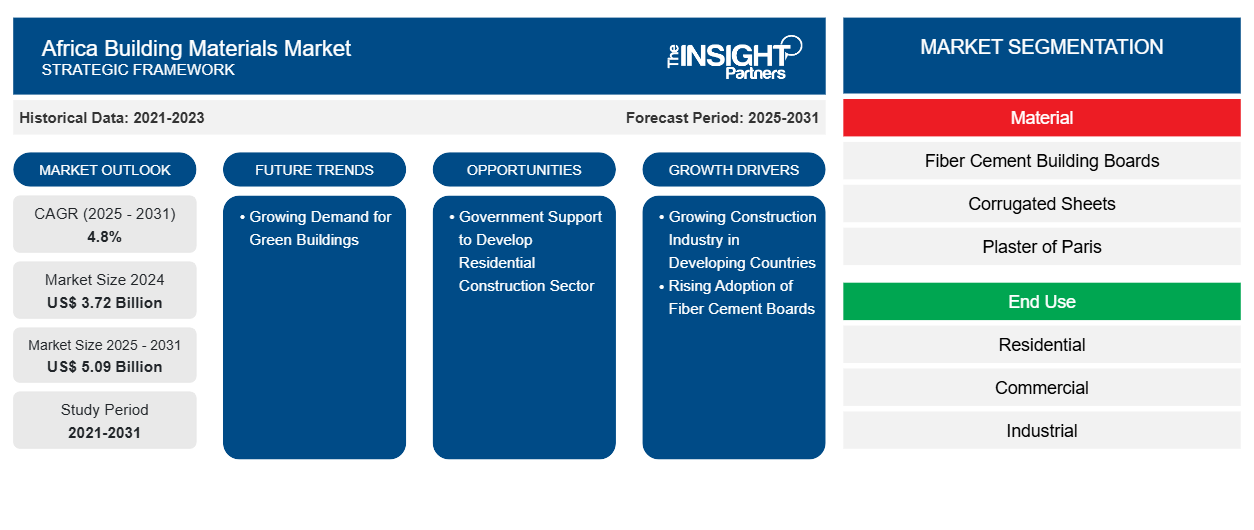预计到2031年,非洲建筑材料市场规模将从2024年的37.2亿美元增至50.9亿美元。预计2025年至2031年期间,该市场的复合年增长率将达到4.8%。绿色建筑需求的不断增长,可能会在未来几年为非洲建筑材料市场带来新的趋势。
非洲建筑材料市场分析
发展中国家城镇化进程推动建筑业增长,刺激了对纤维水泥板、 石膏板、隔热材料和其他必需产品的需求。随着非洲发展中经济体经历快速城镇化、人口增长和基础设施扩张,对耐用且经济高效的建筑材料的需求持续增长。建筑材料可以提高建筑材料的性能、功能性、耐化学性和耐用性。许多非洲国家正在经历从农村到城市的大规模迁移,导致对经济适用房、办公空间和公共基础设施的需求增加。因此,非洲建筑业的强劲增长推动了市场增长。
非洲建筑材料市场概况
非洲建筑材料市场受到住宅、商业、机构、工业和基础设施建设活动显著增长的驱动。非洲各国政府主要关注基础设施建设,推动该地区的基础设施建设活动。2023年10月,中国铁建集团和中国国际信托投资公司在阿尔及利亚修建了一条连接17个省的高速公路。该高速公路总长1020公里。水泥和混凝土因其经济实惠、灵活多变且易于修复而被广泛用于高速公路建设。因此,基础设施建设推动了非洲市场对建筑材料的需求。
您可以免费定制任何报告,包括本报告的部分内容、国家级分析、Excel 数据包,以及为初创企业和大学提供优惠和折扣
非洲建筑材料市场:战略洞察

- 获取此报告的顶级关键市场趋势。此免费样品将包括数据分析,从市场趋势到估计和预测。
非洲建筑材料市场的驱动力和机遇
纤维水泥板的采用率不断上升
非洲建筑材料市场正在经历显著增长,纤维水泥板因其耐用性、防火性、防潮性和成本效益而成为首选建筑材料。纤维水泥墙板、天花板、地板垫层和外墙板的日益普及正在塑造这个行业,特别是在住宅、商业和工业建筑领域。与胶合板和混凝土砌块等传统材料相比,纤维水泥板的优异性能是市场扩张的主要驱动力。建筑师和客户已经广泛认可和赞赏纤维水泥板的众多优势,许多人选择了纤维水泥板解决方案。耐用性是这些板材最理想的品质之一。纤维水泥壁板的使用寿命通常比乙烯基壁板长。在 10-15 年内,乙烯基壁板就会出现老化迹象;然而,纤维水泥壁板的使用寿命可达 30-50 年或更长时间。此外,在水泥生产过程中,温室气体二氧化碳是副产品;然而,生产含有聚氯乙烯 (PVC) 的乙烯基壁板会产生两倍的二氧化碳。此外,乙烯基壁板在其整个使用寿命期间都会排放气体,并且由于占用了垃圾填埋场的空间,排放气体还会持续存在。因此,纤维水泥壁板是乙烯基壁板更环保的替代品。
政府支持发展住宅建筑业
非洲建筑材料市场正在经历显著增长,这主要得益于政府对住宅建设项目的大力支持。由于人口快速增长、城镇化以及经济适用房需求的不断增长,许多非洲国家正面临住房短缺的问题。为此,各国政府正在实施政策、补贴和基础设施投资,以促进住宅建筑行业的发展,这直接增加了对纤维水泥板、石膏板、隔热材料和其他必需建筑材料的需求。2023年6月,科特迪瓦宣布了一项通过国际金融公司(IFC)结构性公私合作伙伴关系扩大经济适用房的计划。2025年3月,IFC向Addoha公司提供了2700万美元的贷款,用于在科特迪瓦建造5600套经济适用房,支持政府到2030年的社会住房计划。尽管一次性塑料面临监管压力,但EPS仍然是冷链物流中一种经济高效且性能卓越的解决方案,预计将在预测期内为该地区带来重要的增长机会。随着各国政府加大力度弥补住房缺口,预计非洲建筑材料行业将在预测期内为非洲建筑材料市场创造丰厚的机会。
非洲建筑材料市场报告细分分析
有助于得出非洲建筑材料市场分析的关键部分是材料和最终用途。
- 根据材料,市场细分为纤维水泥建筑板、瓦楞板、熟石膏、石膏板和绝缘材料。绝缘材料在2024年占据了最大的市场份额。
- 就最终用途而言,市场细分为住宅、商业、工业、机构和基础设施。住宅领域在2024年占据了最大的市场份额。
非洲建筑材料市场份额按地域分析
非洲建筑材料市场报告的地理范围主要分为南非、加纳、喀麦隆、科特迪瓦、尼日利亚、埃及、塞内加尔和非洲其他地区。
就收入而言,尼日利亚在2024年占据非洲建筑材料市场的主导地位。由于尼日利亚建筑项目数量的不断增加,其建筑材料需求正在快速增长。例如,2025年3月,丹格特工业有限公司宣布将在尼日利亚建造最大的海港。新港口将位于奥洛科拉自由贸易区,预计将于2026年底竣工。该公司拥有一座年产1200万吨的水泥厂,合并后,奥贡州将成为尼日利亚最大的水泥生产州,年总产量将达到1800万吨。
非洲建筑材料市场区域洞察
Insight Partners 的分析师已详尽阐述了预测期内影响非洲建筑材料市场的区域趋势和因素。本节还讨论了非洲建筑材料市场在北美、欧洲、亚太地区、中东和非洲以及南美和中美的细分市场和地理位置。

- 获取非洲建筑材料市场的区域具体数据
非洲建筑材料市场报告范围
| 报告属性 | 细节 |
|---|---|
| 2024年的市场规模 | 37.2亿美元 |
| 2031年的市场规模 | 50.9亿美元 |
| 全球复合年增长率(2025-2031) | 4.8% |
| 史料 | 2021-2023 |
| 预测期 | 2025-2031 |
| 涵盖的领域 | 按材质
|
| 覆盖地区和国家 | 非洲
|
| 市场领导者和主要公司简介 |
|
非洲建筑材料市场参与者密度:了解其对商业动态的影响
非洲建筑材料市场正在快速增长,这得益于终端用户需求的不断增长,而这些需求的驱动因素包括消费者偏好的转变、技术进步以及对产品优势的认知度的提升。随着需求的增长,企业正在扩大产品线,不断创新以满足消费者需求,并抓住新兴趋势,从而进一步推动市场增长。
市场参与者密度是指特定市场或行业内企业或公司的分布情况。它表明特定市场空间内竞争对手(市场参与者)的数量相对于其规模或总市值而言。
在非洲建筑材料市场运营的主要公司有:
- 圣戈班公司
- 可耐福隔热材料
- 埃泰克斯公司
- 纯化学工业有限公司
- Vitapur 隔热材料
- 新材料尼日利亚有限公司
免责声明:以上列出的公司没有按照任何特定顺序排列。

- 获取非洲建筑材料市场顶级关键参与者概览
非洲建筑材料市场新闻及最新发展
非洲建筑材料市场的评估是通过收集一手和二手资料后进行的定性和定量数据进行的,这些数据包括重要的企业出版物、协会数据和数据库。以下列出了非洲建筑材料市场的一些发展情况:
- 可耐福集团与Texnopark宣布达成联合协议,可耐福将收购Texnopark的岩矿棉保温业务。此次收购包括位于乌兹别克斯坦塔什干的一家新工厂,该工厂配备先进的电熔技术,可实现低二氧化碳排放生产。(来源:可耐福保温材料,公司新闻,2024年10月)
- 作为新投资阶段的一部分,圣戈班印度公司计划将其玻璃棉和岩棉保温材料的生产能力翻一番,目标是到 2032 年实现所有业务收入 43 亿美元。(来源:圣戈班,新闻稿,2024 年 6 月)
非洲建筑材料市场报告范围和交付成果
《非洲建筑材料市场规模和预测(2021-2031)》报告对以下领域进行了详细的市场分析:
- 非洲建筑材料市场规模以及区域和国家层面涵盖的所有主要市场领域的预测
- 非洲建筑材料市场趋势以及市场动态,如驱动因素、限制因素和关键机遇
- 详细的波特五力模型和 SWOT 分析
- 非洲建筑材料市场分析涵盖主要市场趋势、区域框架、主要参与者、法规和最新市场发展
- 行业格局和竞争分析,涵盖市场集中度、热图分析、知名参与者以及非洲建筑材料市场的最新发展
- 详细的公司简介
- 历史分析(2 年)、基准年、预测(7 年)及复合年增长率
- PEST和SWOT分析
- 市场规模、价值/数量 - 全球、区域、国家
- 行业和竞争格局
- Excel 数据集
近期报告
客户评价
购买理由
- 明智的决策
- 了解市场动态
- 竞争分析
- 客户洞察
- 市场预测
- 风险规避
- 战略规划
- 投资论证
- 识别新兴市场
- 优化营销策略
- 提升运营效率
- 顺应监管趋势




















 获取免费样品 - 非洲建材市场
获取免费样品 - 非洲建材市场